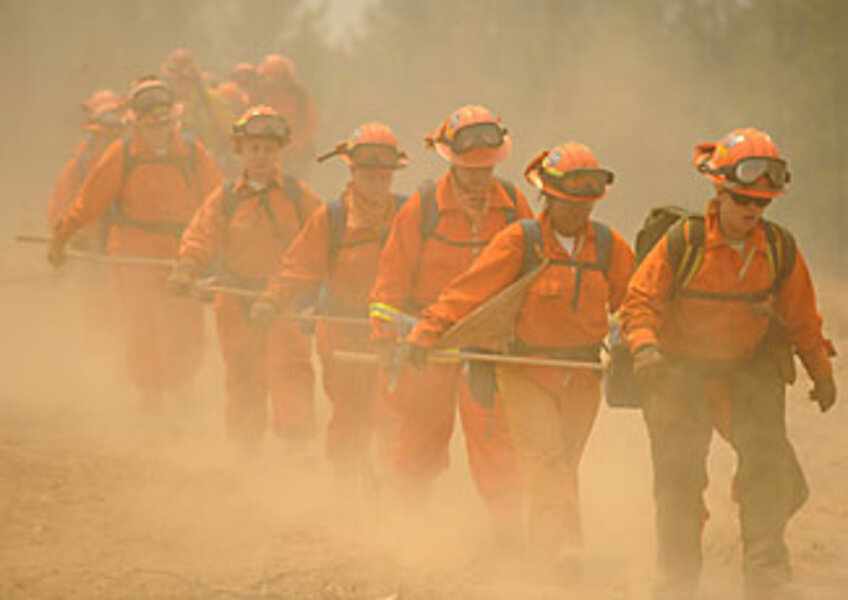How national parks manage fire risk
Loading...
| San Diego
Officials at the Sequoia & Kings Canyon National Park in California adopted an unusual wildfire policy four decades ago: When possible, they'd let fire be fire.
If a blaze didn't threaten homes or people, park officials would let it burn. The idea was to let natural processes take over and prevent wildland from becoming too overgrown and vulnerable to a conflagration.
Forty years on, this strategy – known as "fire management" – is in place in wilderness areas across the West despite constant revision after a catastrophic miscalculation in the late 1980s at Yellowstone National Park in Wyoming. But as this year's extraordinary wildfire season in northern California shows, the strategy isn't always practical.
Firefighters at Yosemite National Park, for instance, normally let fires burn thousands of acres each year, sometimes for weeks. This year, the epidemic of nearby wildfires has caused so much pollution that Yosemite allowed only four fires to burn because of smoke regulations.
The strategy of using fire to prevent future fires "is a luxury," especially given the restrictions regarding its use, says Jan van Wagtendonk, a federal fire researcher who works at Yosemite. Still, he says, "it's the most natural way to allow the ecosystem to perpetuate itself."
Yosemite's longstanding embrace of managed fires would not have prevented last week's wildfire from eventually entering the park and destroying homes and park facilities, Mr. van Wagtendonk says, but it would probably have protected much of the nearly 1,200-square-mile park by reducing the levels of overgrowth.
The so-called Telegraph wildfire last week, said to be caused by a target shooter, burned 21 homes and threatened to enter Yosemite. Firefighters reported Sunday that the fire was mostly under control, although it had burned more than 33,920 acres.
Yosemite allows fires to burn in 80 percent of the park, van Wagtendonk says. In some cases, firefighters burn off overgrown brush in the backcountry; at other times, they "herd" fires caused by lightning.
Monitoring is key, van Wagtendonk says. "We don't put a blindfold on and look the other way."
Controlled or monitored fires don't actually prevent future blazes because brush and trees grow back. "Nothing will stop 200-foot-high flames," says Timothy Ingalsbee, executive director of Firefighters United for Safety Ethics and Ecology. "But when such a fire does encounter one of those areas where they've done prescribed burns, it'll change its intensity. It'll drop to the ground and allow firefighters to get a handle on it."
Firefighters weren't always willing to let fires burn. "The old policy was to put the fire out as quickly as possible, keep it to the smallest size, the shortest duration," Mr. Ingalsbee says. "That's not humanly possible any more in the midst of climate change, invasive weeds, urban sprawl, and a lot of careless recreationists."
Across the National Park Service system, firefighters purposely burned nearly 29,000 acres in the 2007 fiscal year and let natural fires burn another 43,000 acres.
Tom Nichols, chief of the fire and aviation division with the National Park Service, says the managed-fire approach is in place at parks ranging from the Everglades in Florida to the Crater Lake, Grand Teton, and Grand Canyon parks in the West. The US Forest Service also permits fire management in some cases, although critics say it's been slower to adopt the approach than the park service.
There are risks to allowing fires to burn. They can create a health hazard through smoke pollution. And they can whip out of control.
In 1988, dozens of fires at Yellowstone burned nearly 800,000 acres – more than a third of the park – and two firefighters were killed. Three of the biggest fires began as controlled burns.
After an outcry by the public and politicians, federal fire officials set firm guidelines on managed fire.
Today, the federal government continues to tinker with this approach, issuing new guidelines last spring aimed at allowing more flexibility about when a fire can be permitted to burn. There's even a new term: "appropriate management response."
"We have to relearn how to live with fire and work with fire," says Ingalsbee.





